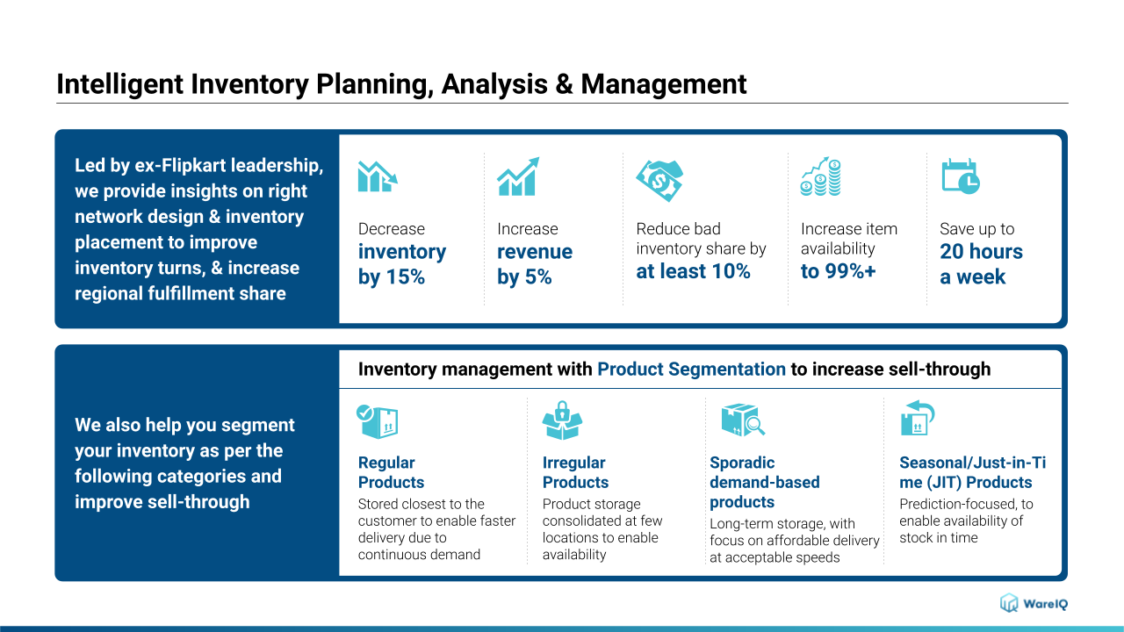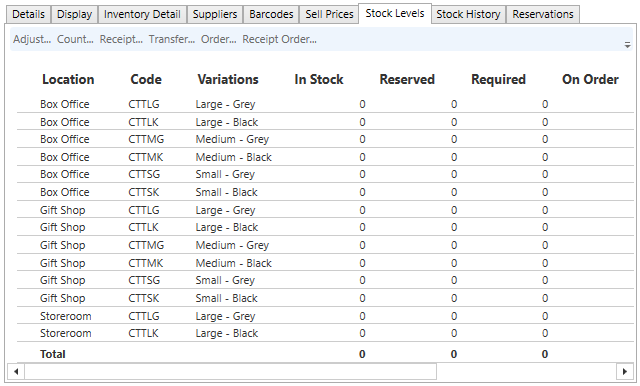What is The Meaning Of Inventory Records? 4 Methods Of Maintaining Accurate Inventory Books In 2024

Inventory is the lifeblood of your company and it is continuously in motion across the supply chain. Examples of the movement of inventory include new shipments of inventory reaching your warehouse, items being serviced and packaged, and more inventory is purchased, shipped, processed, and stored. Businesses need an efficient way of keeping track of all these inventory movements and transactions and this is where inventory records can assist. In this blog, we will take a deeper look into what an inventory record system entails, the importance of keeping these inventory records, the various methods you can use to track them, and the various features that it consists of.
What are Inventory Records?
An inventory record is the collection of all data pertaining to various aspects of the inventory that is maintained by your business. An inventory record comprises information on the type and quantity of merchandise a company has in stock.
Merchandise on hand, inventory on order, and inventory on hold for work-in-progress are all included in the inventory books. It is often referred to as a stock record. Inventory records can be considered as archives of data for every item in a brand’s product range, including:
- The quantity of stock at the SKU level
- The quantity of stock that has been sold and reordered
- The total value of each product
- The location where the inventory is stored
- Other business-related information, such as work-in-process (WIP) inventory data
Each entry must have a description of its SKU and other relevant data. Inventory records can be made and maintained digitally as well as manually.
An accurate inventory record system helps track sales patterns and distinguish between fast-moving and slow-moving items. This helps you to anticipate and plan for surges in demand, ensuring that your most popular goods are properly supplied. This will prevent supply shortages, which can irritate consumers and harm your company’s reputation.
WareIQ, an eCommerce fulfillment company, empowers online brands with a superior-tech platform to compete with Amazon like service levels by bringing their average delivery timelines from 5-10 days to 1-2 days.
Why is Maintaining Accurate Inventory Books Important?
Inventory records may be used for various purposes, ranging from providing information on daily finances to completing yearly taxes. It may be used to establish strategies, increase operational cost-effectiveness and track output volume.
An accurate inventory record shows that you are more likely to be able to fulfill client orders effectively. Customers will trust you if you know exactly what stock you have, where it is, and how much you may need to order to achieve optimum levels. An accurate inventory record system guarantees that you will always have in-demand items on hand, ensuring you never run out of them.
Some ways in which inventory records are essential for your business are as follows:
Ensures Accuracy of Inventory Tracking
Keeping track of the inventory that is being received and is being used continuously promotes inventory visibility and leads to proper balancing of inventory levels.
Inadequate inventory accounts for inventory shrinkage, i.e., the stock being less than the recorded amount in the accounting system and it can produce large disparities that can adversely affect profitability and other financials by creating confusion regarding the availability of items and how much of each item was ordered.
Simplifies Inventory Accounting
Inventory accounting is made considerably easier when accurate inventory records are maintained. The Financial Accounting Standards Board (FASB) and Generally Accepted Accounting Principles (GAAP) require all merchants and manufacturers to keep track of inventory value and count.
To avoid overstating profit by understating inventory value, GAAP requires inventory to be correctly accounted for according to a highly specific set of rules. The GAAP guidelines also prevent a corporation from overstating its worth by overstating the value of its inventory. Inventory influences the total worth of the organization since it is an asset.
You can track changes in value and know how much your inventory is worth at the completion of each accounting period by maintaining a comprehensive inventory recordkeeping method.
Prevents Overstocking and Out-of-Stock Situations
Keeping accurate inventory records allows you to avoid overstocking and better understand when you need to reorder more stock. Determining the exact quantity of stock for numerous product types is a difficult undertaking, whether it is sourcing raw materials for production or estimating the ever-changing client demand for retail sales. If done incorrectly, it might result in one of two equally aggravating issues: overstocking and out-of-stock situations.
Not having enough inventory can lead to out-of-stock problems, while too much inventory can raise carrying costs, potentially leading to too much wastage.
Since inventory moves continually across the retail distribution network, using real-time inventory management systems makes it easier to check whether every item of inventory is available and accounted for while comparing stock levels and electronic records.
Mitigates Uninformed Decisions Made Through Inaccurate Data
Outdated and unsynced inventory records may lead to you and your team running the risk of making crucial business decisions based on incorrect information.
Errors can be minimized by reducing time-consuming, manual efforts by employing technology to manage inventory in real-time.
Inventory management systems, such as inventory applications or a more complex system like ERP inventory software, can be used to track inventory in real-time. These solutions enable you to combine information by integrating your upstream production methods with your downstream sales.
With real-time data linked to inventory, you can also discover patterns and estimate demand, enabling better forecasts on inventory reorder amounts and levels.
4 Methods to Achieve an Up-to-Date Inventory Record System in 2024
To run a successful business, you must keep your inventory precise, simplified, and up to date at all times. If you want to be competitive, you must maintain your inventory with accuracy. When you lose grasp of your inventory, you instantly lose control of your company’s profitability. Furthermore, out-of-stock situations usually result in customer displeasure and losses for businesses.
Thus, an up-to-date inventory system is a prerequisite for the smooth functioning of your business. The 4 most prominent methods for achieving an up-to-date inventory record system are as follows:
Store Tangible Backups
Businesses need to compare their inventory levels from time to time. An inventory audit is a practice of comparing a company’s actual inventory levels to its financial records to assist with proper inventory accounting. To improve inventory auditing efficiency, businesses should preserve physical records of every item of inventory as well as online backups.
In certain countries, keeping original hard copies may be required by law. It also safeguards your data in the event that the security of your cloud server is breached and valuable information is lost.
Consult Your Accountant on the Relevant Information Needed
For the proper management of inventory records and thereby ensuring the smooth running of your business operations, professional help is an important requisite. You should enlist the services of a reliable accountant and ask them for advice on maintaining proper inventory records for your firm.
In most circumstances, the information you require during the accounting period comprises COGS, production inventory (if relevant), beginning inventory, and the value of ending inventory, i.e., what remains at the conclusion of an accounting period.
You may also consult with your accountant about the appropriate inventory valuation technique based on the products you sell and your average sales volume.
Maintain Consistency in Your Accounting Methods
There are numerous techniques for tracking and recording inventory. Whatever approach you use, the most essential aspect is maintaining consistency to ensure accuracy. Consistency is the key to having proper inventory records. At the end of each accounting period or fiscal year, you must determine the value of your inventory.
The following are the most frequent eCommerce valuation methods:
- FIFO (First-in, First-out)
- LIFO (Last-in, First-out)
- Weighted Average of Inventory (WAC)
- Specific identification method
Utilize Advanced Inventory Management Software
Inventory Management systems are concerned with keeping an account of physical quantities and the total monetary worth of goods sold and those in hand. It aids you in tracking items as they arrive at the warehouse or godown and when they are issued for sale. It guarantees that the commercial enterprise’s records are entirely up to speed.
You have two choices while maintaining inventory records:
- After a specific accounting period, update your records (periodic inventory system)
- Every transaction should result in an update to the records (perpetual inventory system)
Adopting a definite inventory system is your best choice as your business expands. This may be accomplished by purchasing inventory management software, which allows you to track inventory movement in real-time, record daily coverage with minimal effort, and automate multiple aspects of inventory management such as record-keeping and tracking data.
Features Offered by Inventory Management Software For Accurate Inventory Record System in 2024
An effective inventory management software is crucial for simple and effective inventory books.
You can optimize inventory to match demand and increase supply chain efficiency by automating the monitoring of all inventory along with real-time adjustments.
You can simply download records and custom reports with the correct software to have all the relevant data you need when it’s time to consult your accountant and also for the smooth and effortless management of inventory.
Some of the more critical features provided by inventory management software are explained below:
Real-Time Insights Across Platforms
As your business grows, you will expand to other avenues besides selling online.
- Direct-to-consumer (DTC) firms may increase their client reach by selling through marketplaces (like Amazon) and social media platforms (such as Instagram).
- As a result, many businesses use multichannel inventory management software, which manages inventory across channels and gathers information in one location.
- Inventory levels are continuously updated in real-time as bought or returned products arrive or leave and sales occur through multiple channels.
- You get visibility into your inventory, save time identifying essential products and eliminate interruptions, theft, and overselling with real-time data sharing.
- Image attachment and barcode/RFID scanning capabilities are two essential tools that enhance tracking and help speed up picking operations. They aid in increasing accuracy and reducing discrepancies.
- When you work with a technology-enabled 3PL, you have access to inventory management systems that allow you to track inventory across channels and distribution centers from one location.
- Instead of depending on different suppliers, retailers can distribute goods across several fulfillment locations and manage inventory in real-time through a single dashboard.
Automated Generation of Reports
The reporting of various business operations is one of the most valuable instruments of an inventory management system.
- People in charge of the inventory of a business must be informed about different business operations such as the availability of delivery personnel, the state of goods, information about the shipment of the order, and so on.
- Many technologies can be integrated into the inventory management software to facilitate reporting of these metrics.
- According to some experts, your inventory management software is only as good as the inventory reports it creates.
- Calculating and tracking this information in spreadsheets or via various integrations might be difficult.
- Inventory management software automatically gathers data, allowing you to generate customized reports whenever you need them.
Reorder Thresholds Based on Past Data
Inventory management software allows you to automatically establish reorder point notifications, allowing you to resupply inventory on time without having to manage to restock manually when each order is placed.
- For many supply managers, automating reordering is one of the most appreciated and stress-relieving aspects of IMS.
- The IMS can be designed to detect low stock levels and subsequently develop and submit purchase orders for the required products, including items sold in packages or packs.
- You can also establish personalized notifications to notify you when you hit the reorder point because you are running low on particular goods.
- The merchandise management program uses past sales data to provide insights on when it is appropriate to reorder more inventory per SKU, allowing you to establish a predefined reorder point.
- It is pointless knowing your exact inventory count and where it is located if it doesn’t prevent you from avoiding stock-out situations.
- As a result, your inventory management software must be capable of establishing automatic notifications when critical stock is running low and must also have the ability to swiftly produce a purchase order in response to that warning.
Conclusion
The finest data in the world won’t help your business if you can’t locate what you’re looking for when you need it. Inventory records are utilized for organizing and managing files, both physically and digitally.
Inventory record systems may be used for various purposes, ranging from providing information on daily finances to completing yearly taxes. It may be used to establish strategies, increase operational cost-effectiveness and track output volume. It is feasible to increase operational efficiency by rearranging and retaining stock in the most advantageous position for production by understanding where and how much of each product is available in stores. It may also assist a business in ensuring that inventory is not wasted, abused, damaged, or lost. Maintaining inventory records independently as your company starts to grow can be a challenge so it is beneficial to partner with a 3PL company like WareIQ.
WareIQ’s core offering is Inventory LogIQ, an AI-driven inventory optimization platform, that helps you take control of your inventory data at geographic and SKU-level to unlock operational agility by enabling you to avoid stock-outs and excess inventory.

WareIQ is one of the fastest expanding eCommerce fulfillment companies in India and can help retailers with a wide range of inventory requirements, including maintaining inventory records. Our advanced WMS provides data and insights on every metric of inventory you need to keep track of it and can automate multiple processes of inventory management to take the burden off you.








